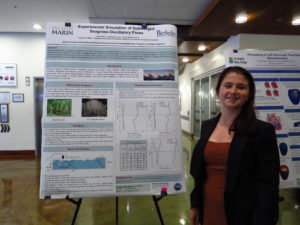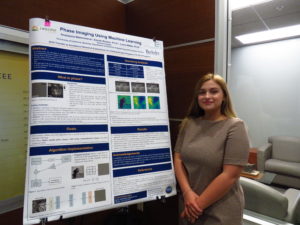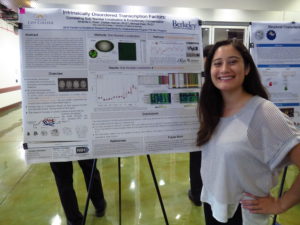Community College Participants and Projects: 2018

Undergraduate Researcher: Zoe Altenberg
Intended Major: Chemical Engineering
Home Institution: Diablo Valley College
Research Project: Mechanism of Cas9 Ribonucleoprotein Uptake in Neural Progenitor Cells
Postdoctoral Advisor: Dr. Brett Staahl
Graduate Student Mentor: Bianca Filart
UC Berkeley Department: Department of Molecular and Cell Biology
Project Abstract: The Cas9 protein, associated with the CRISPR system from bacteria and archaea, is a powerful tool that can be programmed to make precise cuts and edits in DNA1. Combining the Cas9 with a guide RNA forms the Cas9 ribonucleoprotein (RNP) complex. The native Cas9 RNP has no cell-penetrating activity when delivered onto cells; however, engineered RNPs have been reported to increase editing activity, indicating an increase in cell penetration. The next question is how the engineered Cas9 RNP is entering the cells. Preliminary data points toward an endocytic mechanism of entry. By using small molecule inhibitors and endosome antibody markers that target various stages of endocytosis, we’re able to determine the exact pathway by which the RNP enters and moves through the neural progenitor cells (NPCs). These studies will lead to better engineering of the RNP for increased uptake and editing efficiency. Ultimately, this will get the scientific and medical communities closer to developing a successful CRISPR-Cas9 human therapeutic to correct or inactivate genes that cause genetic disorders. Project poster

Undergraduate Researcher: Bond Bortman
Intended Major: Environmental Engineering
Home Institution: Diablo Valley College
Research Project: Mass Transfer Rate of Non-Spherical Particles in Turbulence
Faculty Advisor: Prof. Evan A. Variano
Graduate Student Mentor: Theresa Oehmke
UC Berkeley Department: Department of Civil and Environmental Engineering
Project Abstract: Planktonic organisms, or organisms that drift in water, raise the question of how one finds sustenance or excretes waste without self-propulsion. Using computational methods to solve the Navier-Stokes equations, which describe the flow of incompressible fluids, one can predict how organisms in both the Integral (large) scale and Kolmogorov (small) scale interact with their environment; however, solutions to the Navier-Stokes equations in the Taylor (middle) microscale region are currently too computationally intensive to solve. In order to understand how these organisms interact with their environment, an experimental model of their behavior needs to be created. Organisms are modeled using particles of different shapes and surface areas and are composed of sucrose, dextrose, and glass bubbles. This allows us to measure the mass transfer rate from the particle surface to the surrounding water and will help illustrate how nutrients may transport to and from an organism. It was found that thin rectangular-shaped particles have a higher mass transfer rate than cube-shaped particles, potentially due to their surface area to volume ratio. The particles studied serve as models to further our understanding of how planktonic organisms behave in turbulence. Project poster
 Undergraduate Researcher: Joseph Carter
Undergraduate Researcher: Joseph Carter
Intended Major: Electrical Engineering and Computer Science
Home Institution: Diablo Valley College
Research Project: Antenna-Enhanced Light Emission from Quantum Dots
Research Advisor: Prof. Ming C. Wu
Postdoctoral Mentor: Seth Fortuna
UC Berkeley Department: Department of Electrical Engineering and Computer Science
Project Abstract: We designed an optical antenna with light emitting quantum dots tightly coupled to the antenna mode. We used surface functionalization and conjugation techniques to demonstrate deposition of the quantum dots to a selective area in the antenna feed gap. Project poster
 Undergraduate Researcher: Ailin Chen
Undergraduate Researcher: Ailin Chen
Intended Major: Mechanical Engineering
Home Institution: Ohlone College
Research Project: Spin Transport Across Graphene-Metal Interfaces
Faculty Advisor: Prof. Jeffrey Bokor
Graduate Student Mentor: Juan Pablo Llinas
UC Berkeley Department: Department of Electrical Engineering and Computer Science
Project Abstract: This research aims to improve the efficiency and performance of graphene spintronic devices. Graphene spintronic devices use graphene as a channel to transport electron spin that can be used to process information. Theoretically, graphene has a relatively long spin diffusion length and long spin lifetimes at room temperature compared to other conductors; however, the experimental results of the spin relaxation time for graphene do not meet the theoretical predictions. In addition, the poor spin injection efficiency from the contact metal to graphene is also preventing the development of efficient graphene spintronic devices. To overcome these challenges, we employ a dry transfer method to fabricate the contact between the graphene and the metal electrodes. Using this method to transfer the contact metal onto the graphene, instead of physical vapor deposition techniques such as electron beam evaporation, could potentially lead to a defect-free interface as well as improve the spin injection efficiency. Project poster

Undergraduate Researcher: Lily Cohen
Intended Major: Environmental Engineering
Home Institution: College of Marin
Research Project: Experimental Simulation of Submerged Seagrass-Oscillatory Flows
Faculty Advisor: Prof. Evan A. Variano
Graduate Student Mentor: Alejandro Caceras
UC Berkeley Department: Department of Civil and Environmental Engineering
Project Abstract: Seagrass canopies are fragile ecosystems that are vanishing more quickly than they could ever recover. These ecosystems are important for providing nutrient stirring, biodiversity, and beach stability through retention of particle matter. Much of this comes from seagrass’ effects on waves to create Kelvin-Helmholtz vortices during certain wave conditions. This project’s goal is to find the conditions that create these vortices. In order to find these vortices, we have utilized the Acoustic Doppler Velocimeter (ADV), a wave maker and a simulated plastic rod seagrass canopy. Project poster
 Undergraduate Researcher: Bayan Duwaik
Undergraduate Researcher: Bayan Duwaik
Intended Major: Molecular and Cell Biology
Home Institution: Ventura College
Research Project: Investigating the Role of Single-Stranded DNase Activity By the CRISPR-Cas12a System
Faculty Advisor: Prof. Jennifer A. Doudna
Postdoctoral Mentor: Dr. Tina Liu
UC Berkeley Department: Department of Molecular and Cell Biology
Project Abstract: CRISPR-Cas is an RNA-guided adaptive immune system found in many bacteria and archaea. Recently, studies showed that a CRISPR-Cas system, known as Cas12a, cleaves single-stranded DNA nonspecifically, however the biological role of this activity is not well understood. Cas12a’s single-stranded DNA cleavage activity is similar to that of a different CRISPR-Cas system, known as CRISPR-Csm. The similarities between these two systems has stemmed an interesting question regarding Cas12a’s cleaving potential. The goal of this experiment is to compare the kinetics of DNA cleavage and substrate preference of the two CRISPR-Cas systems, test whether Cas12a can cut transcriptionally active DNA in trans, and test if Cas12a targeting in vivo causes cell toxicity. These experiments could reveal unexpected connections between different CRISPR-Cas systems and lead to new ways of harnessing CRISPR-Cas systems with single-stranded DNA cutting activity for genome engineering. Project poster

Undergraduate Researcher: Nafisa Habib
Intended Major: Computer Science
Home Institution: Los Angeles Valley College
Research Project: Processing of Left Ventricular Flow Data for Reconstruction
Faculty Advisor: Prof. Shawn Shadden
Graduate Student Mentor: Sarah Frank
UC Berkeley Department: Department of Mechanical Engineering
Abstract: Heart disease is the leading cause of death in the United States, accounting for 1 in every 4 deaths. Studies have shown that some blood flow structures are affected by disease states. However, blood flow is very difficult to image, meaning that flow imaging is limited in the clinic. Improved flow imaging has the potential to show changes in blood flow that are contributing to heart failure. The promising imaging technique of phase-contrast MRI [4D flow imaging] can be used to obtain time-resolved three-dimensional information about blood flow. This blood flow information can be used to calculate potential diagnostics related to heart diseases such as peak velocity and blood pressure at the heart wall. However, one of the main limitations of phase-contrast MRI is that the data is noisy. The goal of this project is to process the results from phase-contrast MRI into a format that can be used to speed up a flow reconstruction procedure. For the data we are working with, the first process for this is to create a mesh for the left ventricle. Then, we will identify the mitral and aortic valves. After, the displacement of the wall of the ventricle between time steps will be determined. Currently, this process requires many manual steps, so this work will help automate these processes. Once all these steps are performed, the velocity data can be filtered and reconstructed easily using code developed in the Shadden lab. Project poster
 Undergraduate Researcher: Yaser Khokhar
Undergraduate Researcher: Yaser Khokhar
Intended Major: Bioengineering
Home Institution: Moorpark College
Research Project: Structural Characterization Of The Tec Family Kinase’s Lipid Binding Module
Faculty Advisor: Prof. John Kuriyan
Graduate Student Mentor: Laura Nocka
UC Berkeley Department: Department of Chemistry
Project Abstract: Protein kinases play a major role in cell signal transduction. This project works with the Tec family of non-receptor tyrosine kinases, specifically Tec and interleukin-2-inducible tyrosine kinase (ITK). These proteins can be distinguished from one another through the strength of their autoinhibition as well as their signaling strength. Each Tec family kinase contains several domains, including the Pleckstrin homology and Tec homology (PHTH) region, the kinase, Src homology 2 (SH2), and Src homology 3 (SH3) domains. Together these domains act in conjunction during cell signaling. Specifically in T cells, Tec and ITK have different modes of activation due to variations in their PHTH regions. For example, the role of the PHTH region is to bind with the phosphatidylinositol 3,4,5-triphosphate (PIP3) lipid to allow the ITK kinase to attach to the membrane for cell signaling. However, if PIP3 is not present in the cell, the PHTH binding site is empty, and the Itk signaling mechanism becomes autoinhibited. We will use protein crystallography to determine whether structural differences in the PHTH module of Tec kinases play a role in determining the activation ability of the system. Project Poster
 Undergraduate Researcher: Anastasiia Makhniaieva
Undergraduate Researcher: Anastasiia Makhniaieva
Intended Major: Computer Science
Home Institution: Ohlone College
Research Project: Phase Imaging Using Machine Learning
Faculty Advisor: Prof. Laura Waller
Postdoctoral Mentor: Dr. Emrah Bostan
UC Berkeley Department: Department of Electrical Engineering and Computer Science
Project Abstract: Light is a wave that has both amplitude and phase, however, our eyes and cameras can only detect intensity (i.e., squared-amplitude) values, so they cannot measure phase directly. Retrieving the phase quantitatively is critical to biology, as it is directly related to shape and density maps for most cells and thin tissue samples. In particular, optical systems that are easy to operate and capable of yielding quantitative phase images are desired in bioimaging. Nevertheless, such systems necessitate the design and use of advanced computational algorithms that efficiently produce high-quality phase images from measurements acquired using inexpensive experimental setups. In recent years, the paradigm in designing efficient phase reconstruction algorithms has shifted from optimization-based models to data-driven ones inspired by deep learning. This project aims to develop a phase recovery algorithm using tools and ideas from machine learning. The first steps of our roadmap are to simulate the data acquisition process and test our algorithm via numerical experiments. We then proceed to evaluate the practicality of the method on experimental data. This approach will provide higher quality and computationally cheaper phase images in comparison to those produced today, advancing the STEM community in understanding biology in terms of cells and tissues. Project poster
 Undergraduate Researcher: Alexandro Ochoa
Undergraduate Researcher: Alexandro Ochoa
Intended Major: Engineering Physics
Home Institution: Chabot College
Research Project: In Situ Synthesis of Metal Oxide Nanofiber on Microheater for Low Power Gas Sensing
Faculty Advisor: Prof. Alex Zettl
Graduate Student Mentor: Hu Long
UC Berkeley Department: Department of Physics
Project Abstract: There are many common volatile compounds that are highly hazardous to humans. Increasing the accessibility of gas sensing devices will raise awareness of these hazards in order to eliminate or minimize them. Low power consumption is necessary for the incorporation of gas sensors into modern portable electronics such as smartphones, nanostructured metal oxide sensors show the most promise for supplying this necessity. In this experiment, nanostructured metal oxides were synthesized and their morphologies were characterized with Scanning Electron Microscopy (SEM) for the purpose of producing highly responsive low power gas sensing devices. The performance of the synthesized metal oxides was observed by monitoring their electrical resistance over time as a response to an applied gas at multiple different concentrations. Project poster
 Undergraduate Researcher: Shan Rafique
Undergraduate Researcher: Shan Rafique
Intended Major: Computer Science
Home Institution: San Joaquin Delta College
Research Project: Diffuser Microscope Simulation
Faculty Advisor: Prof. Laura Waller
Graduate Student Mentor: Fanglin Linda Liu
UC Berkeley Department: Department of Mechanical Engineering
Project Abstract: A light field microscope is capable of capturing 3D information within a single shot, but it loses lateral resolution. A combination of a fluorescence microscope with a diffuser is a proposed solution with the goal of obtaining better 3D resolution than a light field microscope equipped with a microlens array. To demonstrate this idea, Zemax, Python, and Matlab are combined to compare the simulation results of different diffusers and microlens arrays. With this research, fluorescence beads are investigated, then experiments on living organisms, such as zebrafish are conducted. The goal is to eventually utilize this technique in improving the diagnosis and treatment of human diseases. Project poster

Undergraduate Researcher: Amanda Ross
Intended Major: Biomechanics Engineering
Home Institution: San Jose City College
Research Project: Intrinsically Disordered transcription Factors: Correlating Sub-Nuclear Localization & Evolutionary Conservation
Faculty Advisor: Prof. Michael Eisen
Postdoctoral Mentor: Dr. Coleen Hannon
UC Berkeley Department: Department of Molecular Cell and Biology
Project Abstract: Transcription factors (TFs) are proteins recognized for having a crucial role in gene expression. There is a great deal known about these proteins and their structured DNA binding domains. However, many TFs also contain intrinsically disordered regions (IDRs), the characterization of which has largely been neglected because they are flexible and unstructured, making them difficult to research. The IDRs of many TFs have been shown to play a role in regulating transcriptional activation, but how it affects this activation is relatively unknown. The goal of this project is to characterize these IDRs by comparing their specific amino acid sequences and sub-nuclear distributions in the Drosophila melanogaster embryo and determine if these features are correlated. Drosophila (the common fruit fly) is investigated because its uncommon embryonic development makes it easier to study nuclei, specifically the intrinsically disordered TFs inside the nuclei. IDR analysis may determine a correlation between amino acid sequences and TF localization within the nucleus that can be used for characterization of IDRs. The classification of different IDRs within Drosophila TFs will shed light on the intrinsically disordered proteomics as a whole. Project poster

Undergraduate Researcher: Markus Thiel
Intended Major: Chemical Engineering and Material Science Engineering
Home Institution: Merritt College
Research Project: Encapsulation of Quasi-One-Dimensional Transition Metal Trichalcogenides
Faculty Advisor: Prof. Alex Zettl
Graduate Student Mentor: Hu Long
UC Berkeley Department: Department of Physics
Project Abstract: Transition metal trichalcogenides (TMTs) offer a rich group of quasi-one-dimensional materials to study for their interesting physical properties. The TMT structure is comprised of trigonal prismatic chains held together by van der Waals bonding. Altering the crystal dimensions, thereby altering the van der Waals bonding between chains, should affect the TMT physical properties. Here, we report one approach to isolating TMTs down to the quasi-one-dimensional limit as a first-step to exploring the physical property relation to dimensionality. Project poster
